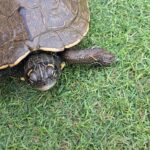If there ever was an aquarium fish that could be labeled as ‘endearing’, it has to be Diodon holocanthus. Also known as the porcupine puffer fish (or blowfish, in non-aquarist circles), this funny looking species is appreciated for its strange appearance and big personality.
Keep reading for everything you need to know about porcupine puffer fish care and keeping this species in your marine aquarium!
| Name (Common, Scientific) | Porcupine puffer fish, porcupinefish, blowfish, balloonfish, Diodon holocanthus |
| Minimum tank size | 200 gallons |
| Minimum group size | 1 |
| Temperature | 75-82 °F |
| Salinity | 1.020-1.025 |
| pH | 8.1-8.4 |
| Difficulty level | Hard |
Porcupine puffer fish (Diodon holocanthus) description
Of course, their looks are what this species is famous for. A relaxed porcupine puffer fish is oval-shaped, with spikes lying flat all over its body. Its strong, beak-like teeth cause a sort of permanent awkward smile. Brownish in color with black spots, they’re also sometimes referred to as the freckled porcupinefish.
Of course, the magic happens when a porcupine puffer is agitated. Like other puffer fish, they possess the ability to swallow large amounts of water, causing them to puff up. The difference is that the porcupine puffer fish, unlike other puffers, has spikes. These stand straight up when the fish inflates, making for a pretty menacing display!
The porcupine puffer fish is not a small species. They can reach a size of 20”.
Did you know? Porcupinefish are not true pufferfish (family Tetraodontidae). Rather, they belong to the family Diodontidae. You can read more about the differences between the two in the article about pufferfish vs blowfish.
Porcupine puffer fish (Diodon holocanthus) aquarium
As mentioned above, the porcupine puffer fish is not among the smaller marine species. One of the reasons it’s considered difficult to keep is the sheer tank size necessary to keep one happy and healthy. Some sources consider 100 gallons adequate, but we personally lean more towards a 200-gallon minimum for this puffer.
The reason for this recommended aquarium volume is not just the porcupine puffer’s size. Like other puffers, they’re also extremely messy eaters that tend to scatter food bits all over the aquarium and produce a lot of waste. In a smaller set-up, water quality can quickly plummet.
Aside from a large aquarium, you’ll also need a powerful filtration system. Provide plenty of hiding places but be sure to also leave your porcupine puffer fish some room to swim.
Tip: You should never expose your porcupine puffer fish to air. Their stress reaction of puffing up can cause them to ingest air, which is then almost impossible to expel.
Porcupine puffer fish (Diodon holocanthus) compatibility
Choosing tankmates for a porcupine puffer fish is not the easiest task. Smaller species can be considered food, while anything slow-moving or possessing long, flowy fins presents a fun opportunity for nipping at.
Larger, aggressive species won’t be appreciated either: they can really stress your porcupine puffer out. Tangs and wrasses tend to be considered alright choices, but really, these funky fish shine most when they’re kept alone.
You can keep your porcupine puffer fish with more members of its own species, as they do occur in groups, especially when they’re younger. It’s not an easy feat, though, considering the species’ waste output.
As for reefs, you might want to forget about that. This porcupinefish has evolved specifically to eat invertebrates.

Porcupine puffer fish (Diodon holocanthus) diet
Before considering a porcupine puffer fish as a pet, you’ll have to think about whether you’re willing and able to deal with the diet they require. A bit like rabbits, porcupinefish teeth never stop growing. This comes in handy if you live off molluscs and other invertebrates whose hard shells can easily wear down your chompers!
In the aquarium, this poses a problem. You have to feed your porcupine puffer fish a diet consisting (almost) completely of hard foods like in-shell mussels, clams, crab and the like. If you don’t, your fish will eventually be unable to eat due to overgrown teeth.
It’s possible to cut or file down porcupinefish teeth, but of course, prevention is better than cure. The process can be very stressful to your fish and if something goes wrong, might even turn out fatal.
Conclusion
The porcupine puffer fish is an incredibly fun fish to keep. It can learn to recognize its owner and will enthusiastically respond to your presence. The species even sometimes blows water out of the tank during feeding time!
This being said, this is not a fish for beginning aquarists. Not sure you have what it takes? We can help. FantaSEA Aquariums can design, build and maintain your fish tank for you so all you have to do is enjoy it. Contact us here for more information.





